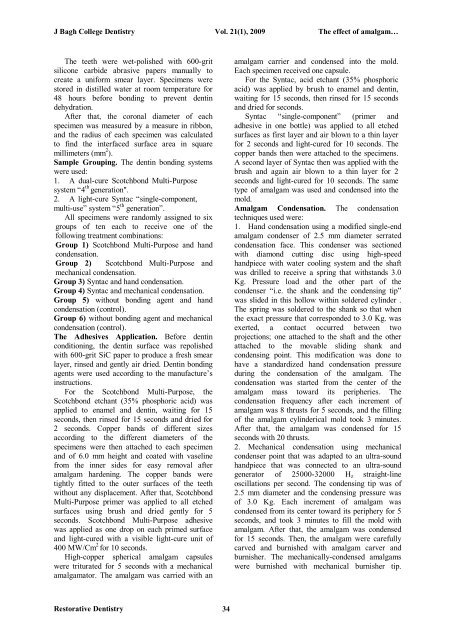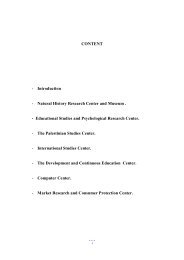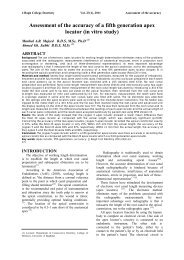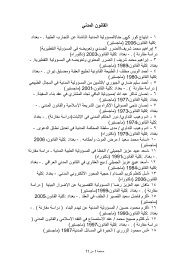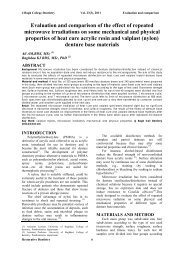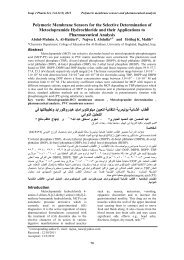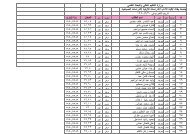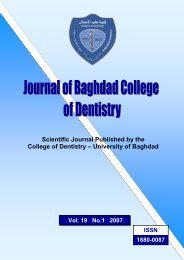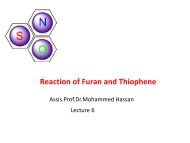Vol 21 No. 1
Vol 21 No. 1
Vol 21 No. 1
You also want an ePaper? Increase the reach of your titles
YUMPU automatically turns print PDFs into web optimized ePapers that Google loves.
J Bagh College Dentistry <strong>Vol</strong>. <strong>21</strong>(1), 2009 The effect of amalgam…<br />
The teeth were wet-polished with 600-grit<br />
silicone carbide abrasive papers manually to<br />
create a uniform smear layer. Specimens were<br />
stored in distilled water at room temperature for<br />
48 hours before bonding to prevent dentin<br />
dehydration.<br />
After that, the coronal diameter of each<br />
specimen was measured by a measure in ribbon,<br />
and the radius of each specimen was calculated<br />
to find the interfaced surface area in square<br />
millimeters (mm 2 ).<br />
Sample Grouping. The dentin bonding systems<br />
were used:<br />
1. A dual-cure Scotchbond Multi-Purpose<br />
system “4 th generation".<br />
2. A light-cure Syntac “single-component,<br />
multi-use” system “5 th generation”.<br />
All specimens were randomly assigned to six<br />
groups of ten each to receive one of the<br />
following treatment combinations:<br />
Group 1) Scotchbond Multi-Purpose and hand<br />
condensation.<br />
Group 2) Scotchbond Multi-Purpose and<br />
mechanical condensation.<br />
Group 3) Syntac and hand condensation.<br />
Group 4) Syntac and mechanical condensation.<br />
Group 5) without bonding agent and hand<br />
condensation (control).<br />
Group 6) without bonding agent and mechanical<br />
condensation (control).<br />
The Adhesives Application. Before dentin<br />
conditioning, the dentin surface was repolished<br />
with 600-grit SiC paper to produce a fresh smear<br />
layer, rinsed and gently air dried. Dentin bonding<br />
agents were used according to the manufacture’s<br />
instructions.<br />
For the Scotchbond Multi-Purpose, the<br />
Scotchbond etchant (35% phosphoric acid) was<br />
applied to enamel and dentin, waiting for 15<br />
seconds, then rinsed for 15 seconds and dried for<br />
2 seconds. Copper bands of different sizes<br />
according to the different diameters of the<br />
specimens were then attached to each specimen<br />
and of 6.0 mm height and coated with vaseline<br />
from the inner sides for easy removal after<br />
amalgam hardening. The copper bands were<br />
tightly fitted to the outer surfaces of the teeth<br />
without any displacement. After that, Scotchbond<br />
Multi-Purpose primer was applied to all etched<br />
surfaces using brush and dried gently for 5<br />
seconds. Scotchbond Multi-Purpose adhesive<br />
was applied as one drop on each primed surface<br />
and light-cured with a visible light-cure unit of<br />
400 MW/Cm 2 for 10 seconds.<br />
High-copper spherical amalgam capsules<br />
were triturated for 5 seconds with a mechanical<br />
amalgamator. The amalgam was carried with an<br />
amalgam carrier and condensed into the mold.<br />
Each specimen received one capsule.<br />
For the Syntac, acid etchant (35% phosphoric<br />
acid) was applied by brush to enamel and dentin,<br />
waiting for 15 seconds, then rinsed for 15 seconds<br />
and dried for seconds.<br />
Syntac “single-component” (primer and<br />
adhesive in one bottle) was applied to all etched<br />
surfaces as first layer and air blown to a thin layer<br />
for 2 seconds and light-cured for 10 seconds. The<br />
copper bands then were attached to the specimens.<br />
A second layer of Syntac then was applied with the<br />
brush and again air blown to a thin layer for 2<br />
seconds and light-cured for 10 seconds. The same<br />
type of amalgam was used and condensed into the<br />
mold.<br />
Amalgam Condensation. The condensation<br />
techniques used were:<br />
1. Hand condensation using a modified single-end<br />
amalgam condenser of 2.5 mm diameter serrated<br />
condensation face. This condenser was sectioned<br />
with diamond cutting disc using high-speed<br />
handpiece with water cooling system and the shaft<br />
was drilled to receive a spring that withstands 3.0<br />
Kg. Pressure load and the other part of the<br />
condenser “i.e. the shank and the condensing tip”<br />
was slided in this hollow within soldered cylinder .<br />
The spring was soldered to the shank so that when<br />
the exact pressure that corresponded to 3.0 Kg. was<br />
exerted, a contact occurred between two<br />
projections; one attached to the shaft and the other<br />
attached to the movable sliding shank and<br />
condensing point. This modification was done to<br />
have a standardized hand condensation pressure<br />
during the condensation of the amalgam. The<br />
condensation was started from the center of the<br />
amalgam mass toward its peripheries. The<br />
condensation frequency after each increment of<br />
amalgam was 8 thrusts for 5 seconds, and the filling<br />
of the amalgam cylinderical mold took 3 minutes.<br />
After that, the amalgam was condensed for 15<br />
seconds with 20 thrusts.<br />
2. Mechanical condensation using mechanical<br />
condenser point that was adapted to an ultra-sound<br />
handpiece that was connected to an ultra-sound<br />
generator of 25000-32000 H z straight-line<br />
oscillations per second. The condensing tip was of<br />
2.5 mm diameter and the condensing pressure was<br />
of 3.0 Kg. Each increment of amalgam was<br />
condensed from its center toward its periphery for 5<br />
seconds, and took 3 minutes to fill the mold with<br />
amalgam. After that, the amalgam was condensed<br />
for 15 seconds. Then, the amalgam were carefully<br />
carved and burnished with amalgam carver and<br />
burnisher. The mechanically-condensed amalgams<br />
were burnished with mechanical burnisher tip.<br />
Restorative Dentistry 34


